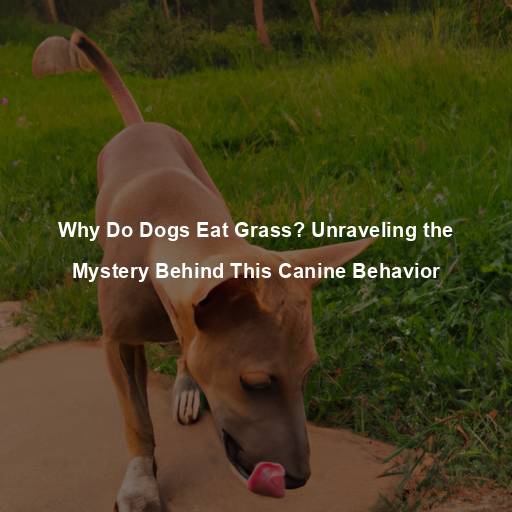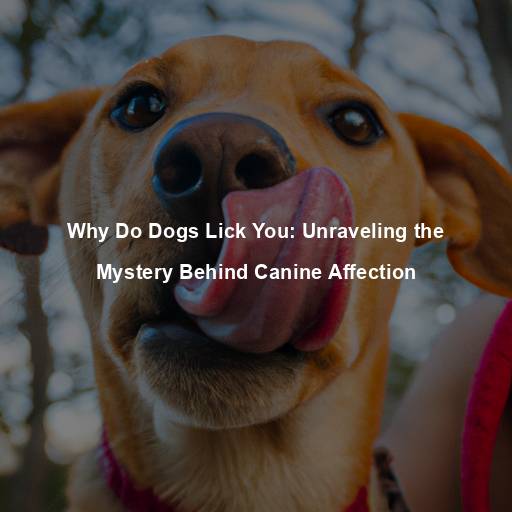Why Do Dogs Eat Grass? Unraveling the Mystery Behind This Canine Behavior
Last Updated on July 19, 2023 by Evan
Contents [hide]
- 1 The Curious Case of Canine Cuisine
- 1.1 The Natural Instincts of Our Canine Companions
- 1.2 Dietary Aid or Digestive Distress?
- 1.3 The Fiber Factor: A Nutritional Perspective
- 1.4 Boredom Busters: Entertainment and Behavioral Enrichment
- 1.5 The Influence of Pica: An Abnormal Craving
- 1.6 The Role of Evolution: An Adaptive Behavior
- 1.7 Environmental Factors: Seeking Phytochemicals
- 1.8 A Behavioral Quirk: Personal Preference
- 2 To Worry or Not to Worry?
- 3 Understanding Your Canine Companion: Observing and Interacting
- 3.1 Spend Quality Time Together
- 3.2 Observe Body Language
- 3.3 Provide Mental Stimulation
- 3.4 Regular Veterinary Check-ups
- 3.5 Positive Reinforcement Training
- 3.6 Tail Wagging: A Language of Emotion
- 3.7 Sniffing: The Canine Superpower
- 3.8 Howling: A Melodic Communication
- 3.9 Digging: Unearthing Canine Instincts
- 3.10 Chasing: The Thrill of the Hunt
- 3.11 Cuddling: Seeking Comfort and Connection
- 3.12 Barking: Vocal Expression
- 4 Unraveling the Canine Mysteries: A Lifelong Journey
- 5 FAQs – Why do dogs eat grass?
The Curious Case of Canine Cuisine
Dogs have a reputation for their indiscriminate eating habits, but one peculiar dietary choice often leaves pet owners scratching their heads – why do dogs eat grass? This seemingly odd behavior has puzzled experts and dog lovers alike, prompting numerous theories and speculations. In this article, we will delve into the fascinating world of canine behavior, exploring the possible reasons behind dogs’ affinity for grass consumption.
The Natural Instincts of Our Canine Companions
The enigmatic allure of why dogs indulge in the peculiar habit of chomping on grass has puzzled us for ages. Delving into the depths of their primal instincts unveils a captivating narrative. Despite their domestication, our canine companions ardently cling to the vestiges of their ancestral heritage. Long ago, their progenitors, as true omnivores, feasted on a medley of sustenance to satiate their nutritional cravings.
Dietary Aid or Digestive Distress?
One popular theory suggests that dogs eat grass to alleviate digestive discomfort. It is believed that grass acts as a natural emetic, inducing vomiting and helping dogs expel unwanted substances from their stomachs. While this theory might explain instances where dogs consume grass and subsequently vomit, it does not account for the majority of cases where dogs simply graze without any apparent signs of distress.
The Fiber Factor: A Nutritional Perspective
When it comes to our loyal canine companions, there is an intriguing new perspective on the role of grass in their diet. Some experts argue that grass, in small, carefully measured amounts, can actually offer nutritional advantages to dogs. You see, grass contains dietary fiber, which has a profound impact on digestion and the ever-important bowels. For dogs who battle bothersome constipation or irregular bathroom habits, this green goodness could be just the ticket.
Boredom Busters: Entertainment and Behavioral Enrichment
Dogs are highly intelligent and social creatures that thrive on mental and physical stimulation. Some experts suggest that grass consumption may serve as a form of entertainment and behavioral enrichment for our canine companions. Just like humans engage in various activities to alleviate boredom, dogs may turn to grass-eating as a means of keeping themselves occupied. However, it is important to note that excessive grass consumption, particularly if it leads to gastrointestinal issues, should be addressed by a veterinarian.
The Influence of Pica: An Abnormal Craving
Have you ever wondered why your furry friend has a peculiar habit of munching on grass? Well, it turns out that dogs who exhibit this baffling behavior may be experiencing a condition known as pica. Pica is characterized by the consumption of non-food items, and in the case of dogs, it seems to manifest as an insatiable longing for strange substances that are not part of their typical diet. It’s still a puzzle as to why exactly dogs develop pica, but experts suggest that it could be attributed to nutritional deficiencies, underlying medical problems, or even behavioral quirks.
The Role of Evolution: An Adaptive Behavior
In the fascinating world of evolutionary biology, some knowledgeable minds put forth a bewildering hypothesis that the act of dogs devouring grass may actually have a purpose – how perplexing! You see, in the wild, our furry friends would occasionally feast upon the herbivorous prey’s stomach contents, which often included bits of plants, like grass. Could it be that by munching on grass, dogs are unknowingly reconnecting with their ancestral ways, utilizing this mysterious behavior to aid their digestion or perhaps even acquire vital nutrients found in the stomach contents of their prey? Truly a puzzling phenomenon!
Environmental Factors: Seeking Phytochemicals
In the fascinating world of plants, an astonishing variety of phytochemicals resides, holding within their delicate essence a promise of potential health benefits. Enter dogs, with their extraordinary olfactory powers, seemingly captivated by the mysterious aromas and tastes of select grasses. Although studies on the exact phytochemicals responsible for this peculiar canine behavior are sparse, a tantalizing hypothesis emerges: perhaps dogs possess an innate knack for detecting and seeking out these advantageous compounds.
A Behavioral Quirk: Personal Preference
Lastly, it is essential to acknowledge that dogs, like humans, possess individual preferences and quirks. Some dogs may simply enjoy the taste or texture of grass, much like humans have their own culinary predilections. While this explanation may not encompass all cases of grass-eating behavior, it highlights the diversity and individuality within the canine world.
To Worry or Not to Worry?
The world of canine grass-eating habits is a perplexing maze that we must navigate with caution. While it is commonly believed that dogs casually nibble on grass without any harm, there are concerns that arise from this seemingly innocent behavior. If your beloved four-legged friend starts indulging in this green delicacy a bit too often or shows signs of discomfort, it’s time to seek professional advice. Consulting with a knowledgeable veterinarian will help uncover any hidden health issues and offer invaluable guidance on maintaining your dog’s dietary well-being.
To unpack the enigma of why our beloved canines find solace in chomping on grass, we delve into a labyrinth of possibilities. Instincts passed down from their ancestors, nutritional deficiencies that trigger their taste buds, a yearning for mental stimulation, or simply, a peculiar palate – all could contribute to their desire. Though pinning down the definitive motivation for this behavior seems elusive, it remains paramount to diligently oversee their grass consumption and prioritize their overall welfare. When you witness your furry companion indulging in this verdant feast, take a moment to marvel at the intricate layers that shape their insatiable curiosity.
We all know that dogs love the occasional nibble on grass, but have you ever wondered if it’s actually good for them? Well, it turns out that there’s more to this innocent habit than meets the eye. You see, some grasses are treated with all sorts of chemicals that can be harmful to our furry friends. And let’s not forget about those sneaky little plants like foxtails and grass awns that can cause serious damage if swallowed.
When to Seek Veterinary Guidance
If your furry companion exhibits any concerning symptoms or if you notice a sudden change in their grass-eating behavior, it is advisable to consult with a veterinarian. They can help determine whether there is an underlying medical condition contributing to this behavior or if further evaluation is needed. Remember, your veterinarian is the best resource for personalized advice and guidance specific to your dog’s needs.
Addressing Nutritional Needs: Balanced Diets for Dogs
When it comes to your fluffy companion’s happiness and health, nothing is more important than providing them with a well-rounded and nourishing diet. While the idea of your pooch munching on grass might seem intriguing, it’s crucial to remember that it cannot replace a meticulously crafted dog food. Every dog is unique, and their nutritional needs vary depending on factors like age, breed, size, and existing health issues. For a truly tailored and balanced diet that caters to your furry friend’s individual requirements, it’s always wise to seek guidance from your trusted veterinarian.
Understanding Your Canine Companion: Observing and Interacting
Our connection with our four-legged companions is a mysterious and ever-evolving bond. To truly grasp the intricacies of their canine nature, we must delve into the depths of observation and engagement. Here, we unveil a treasure trove of invaluable wisdom to nourish your comprehension of your furry confidant. Prepare to embark on a captivating journey of illumination, as you unlock the enigmatic world of your beloved canine companion.
Spend Quality Time Together
Dedicate regular quality time to engage in activities with your dog. Whether it’s playing games, going for walks, or simply cuddling on the couch, this bonding time allows you to build a stronger connection and better understand their unique personality.
Observe Body Language
Pay attention to your dog’s body language. Dogs communicate through various cues, such as tail wagging, ear position, and vocalizations. Understanding these signals can help you interpret their emotions and reactions more accurately.
Provide Mental Stimulation
Offer your dog opportunities for mental stimulation, such as puzzle toys, obedience training, or interactive games. Mental exercise is just as important as physical exercise and can help prevent boredom and potentially destructive behavior.
Regular Veterinary Check-ups
Schedule regular veterinary check-ups for your dog. Routine examinations allow your veterinarian to monitor your dog’s health, address any concerns, and provide guidance on their overall well-being.
Positive Reinforcement Training
Utilize positive reinforcement training techniques to teach your dog desirable behaviors. Reward-based training methods not only strengthen the bond between you and your dog but also promote a positive and cooperative relationship.
Tail Wagging: A Language of Emotion
When it comes to our furry friends, there’s nothing quite like a wagging tail to melt our hearts. But before we jump to conclusions about our canine companions, it’s important to remember that tail wagging isn’t always a one-size-fits-all expression of joy. In fact, the speed, rhythm, and overall demeanor of the wag can reveal a treasure trove of emotions that go beyond simple happiness. So, next time you catch your pup’s tail in motion, take a moment to appreciate the subtle nuances and decode the fascinating messages they’re trying to convey.
Sniffing: The Canine Superpower
Dogs possess an extraordinary sense of smell, far surpassing our human capabilities. Sniffing is an innate behavior that allows dogs to gather information about their environment, other animals, and even human emotions. From tracking scents to detecting diseases, sniffing is a remarkable aspect of canine behavior that showcases their unique sensory abilities.
Howling: A Melodic Communication
The primal echoes of howling weave a captivating tapestry in the intricate tapestry of a dog’s heritage. A timeless language, ancient and untamed, whispered through the ages. Loneliness dances on the edge of their soulful serenade, while their ears prick at the distant melodies that awaken the wild within. Born from the very blood that flowed through the veins of mighty wolves, every howl is a haunting tribute to the untamed spirit that still beats within their hearts.
Digging: Unearthing Canine Instincts
Have you ever wondered why dogs love to dig? Digging is a behavior that can be traced back to dogs’ ancestral roots. In the wild, dogs would dig to create dens, find prey, or regulate their body temperature. Domesticated dogs may exhibit digging behavior out of boredom, to bury treasured items, or simply as a way to release excess energy.
Chasing: The Thrill of the Hunt
The innate instinct to chase runs deep in a dog’s veins. Their primal nature compels them to pursue everything that moves, be it a bouncing ball or a nimble squirrel. Although it may bring a twinkle to our eyes, it is paramount to prioritize the safety of both our furry friends and those in their vicinity. By orchestrating supervised play sessions and providing suitable toys, we can bask in the delights of their chasing antics while keeping them out of harm’s way.
Cuddling: Seeking Comfort and Connection
Contrary to popular belief, not all dogs are natural cuddlers. However, many dogs do seek physical affection and closeness with their human companions. Cuddling is a behavior that reinforces the bond between dogs and their owners, providing comfort and a sense of security. Each dog has its own preferences when it comes to cuddling, so it is essential to respect their boundaries and ensure that cuddling is a positive experience for both parties.
Barking: Vocal Expression
Dogs, oh dogs, their barks can be a curious cacophony of communication! These vocalizations, dear reader, serve a myriad of purposes – from alerting us to potential peril, to expressing wild elation, to simply demanding our undivided attention. Yet, my dear companion, excessiveness in this melodic symphony of barks may interweave intricate tales of anxiety and ennui. By delving deep into the labyrinthine depths of trigger identification and bestowing upon our canine companions the gift of well-rounded training and mental stimulation, we shall surely unveil the hidden secrets of barking, and tame its tumultuous tempest.
Unraveling the Canine Mysteries: A Lifelong Journey
As we explore the vast realm of canine behavior, it becomes clear that dogs are complex creatures with a rich inner world. Their behaviors are influenced by a combination of instinct, genetics, environment, and individual personality. By observing, interacting, and nurturing our canine companions, we embark on a lifelong journey of unraveling the mysteries that make them so captivating.
So, the next time you witness your dog engaging in one of these intriguing behaviors, take a moment to appreciate the depth and diversity of their canine nature. Cherish the opportunity to understand and connect with your furry friend on a deeper level, as you continue to unravel the fascinating tapestry of the canine mind.
FAQs – Why do dogs eat grass?
Why do dogs eat grass?
Dogs eat grass for various reasons, and it can differ from one dog to another. One common reason is that eating grass helps dogs alleviate dietary distress or digestive issues, such as an upset stomach or nausea. Grass can act as an irritant that induces vomiting, which may provide temporary relief to their discomfort. Additionally, some dogs may be naturally inclined to eat grass due to their instinctual behaviors inherited from their wild ancestors. It’s possible that dogs eat grass to fulfill their dietary needs, such as obtaining fiber or additional nutrients that may be lacking in their regular diet.
Is it normal for dogs to eat grass?
Grass, the green carpet of the earth, holds a curious appeal for our beloved furry friends. It’s no secret that dogs occasionally find themselves munching on these leafy blades, without any repercussions. Surprisingly, a staggering 79% of dog owners have attested to witnessing their canine companions indulge in this perplexing grass-gobbling habit. Nonetheless, should your dog’s grass-eating journeys take a peculiar route or provoke any out-of-the-ordinary conduct, paying a visit to a trusted veterinarian would be a wise move to untangle any underlying health puzzles.
Are there any risks associated with dogs eating grass?
While it may seem like a harmless habit, there are a few considerations to keep in mind when it comes to your furry friend munching on grass. Although most cases pose no cause for concern, there are potential risks lurking in the greenery. Dogs can inadvertently consume harmful substances such as pesticides or fertilizers that have been applied to the grass, jeopardizing their well-being. Moreover, the presence of certain herbicides or chemicals on treated grass can prove toxic if ingested in large quantities. Ensuring that your dog’s grazing area is free from these perils is of utmost importance. If uncertainty looms over the safety of the grass in your vicinity, it is wise to supervise your dog’s outdoor excursions closely or grant them access to a designated patch of green that is guaranteed to pose no harm
Should I prevent my dog from eating grass?
If your furry friend has been munching on the green stuff, fear not! It’s quite common for dogs to nibble on grass, and in most cases, it’s completely harmless. In fact, it might even have some surprising benefits for their health. However, it’s always good to stay vigilant. If you notice your pup suddenly turning into a grass aficionado or displaying any odd behavior, it’s best to seek the advice of a trusted veterinarian who can help unravel the mystery.
How can I discourage my dog from eating grass?
For those perplexed by their furry friends’ fascination with grass, fear not! There are several approaches to dissuade dogs from devouring those green blades. One potential solution is to ensure that your pet’s diet is well-rounded and packed with the necessary nutrients, thereby minimizing the need for additional grassy munchies. Engaging your pooch in regular exercise and brain-teasers can also help divert their attention from the forbidden feast. Moreover, if your canine’s grass-gobbling is linked to an unsettled stomach, consider adjusting their meal size or seeking guidance from a trusted veterinarian. Nevertheless, it’s crucial to acknowledge that some dogs are simply fond of the verdant delicacy, making the quest for prevention a burst of uncertainty.






